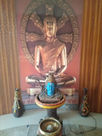Why try Yin Yoga?
- doingyoganow
- Jul 2, 2019
- 2 min read
Yin Yoga emerged in response to an increasingly active and stressful lifestyle. In the traditional Chinese concept of Yin and Yang, activity, restlessness and rapid thinking are all associated with Yang. Its counterpart, Yin is represented by restfulness, passivity and stillness of mind.

Caterpillar
Pose
Using props, bolsters and blankets for support, practitioners find themselves able to release a lot of physical and mental tension through spending on average 3-7 minutes in a pose. The techniques practised in Yin Yoga allow you more time to explore and understand what's going on in your body and mind.

ON a purely physical level, holding a stretch for longer stimulates the connective tissues and fascia that connect the muscles, which facilitates micro-releases throughout the entire body - you will feel the difference after you have allowed yourself over a minute in the asana.
Sometimes holding a pose for a long time requires more mental than physical effort. It is useful to distract a racing mind by continuously scanning the body and see where there's more space to stretch out or sink into. This practice also strengthens the mind-body connection as you become familiar with your physiology as it is revealed to you through the stretches.
Many people experience profound realisations or intense emotions while practising yin yoga; it is said that this comes with the sense of surrender and "letting go" that that is encouraged in the physical sense of relaxing deeply in the pose. When the active mind is relaxed, we start to engage more with the subconscious mind which stores all sorts of things that we may not think about much at all. While these practices are useful for "clearing out the junk" or releasing blocked emotions, they are also able to act in a more constructive capacity. When we enter a state of deep relaxation and connect with the subconscious, we have the option to implant ideas and suggestions for ourselves. Simply allowing yourself to completely relax (with or without setting an intention) is training the subconscious mind to favour a relaxed state. If your subconscious state is relaxed, secure and happy, you will find that your conscious thoughts follow.
Yin Yoga is closely linked to Traditional Chinese Medicine and poses are associated with elements according to the meridians they affect. Like many ancient holistic sciences, there are many similarities between the concepts of TCM and Ayurveda. In Yin Yoga, you will balance your chi and your chakras and connect with the energetic bodies.
“The most important thing to me is not a static posture, but the essence of the posture. If you are in a posture and you have the ability to flow with the energetic quality of one of the elements or animals, then you can understand its purpose.” Paulie Zink, founder of Yin Yoga







Comments